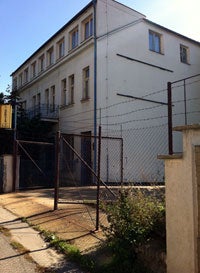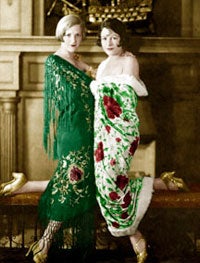To get to the Národní Filmový Archiv (Czech National Film Archive) in the Žižkov district from Vysočny, where my 82-year-old aunt lives and I stay when in Prague, I take a subway to almost the center of town to Florenc, then backtrack by bus to Malešická Street, where I’m deposited not one hundred yards from the Archive. The NFA’s offices are in a strangely pastoral environment, thanks to an adjacent railway line, even though in the middle of the city. I’m there to see a nitrate print of Good References (1920, Roy William Neill), a “lost” Constance Talmadge film that Hugh Neely pointed me towards.

On my way to the Archive’s offices, I run into Vladimir Opela, the longtime director of NFA. Mr. Opela apologizes and says he is off to do a radio interview. I’ve heard from other Czech colleagues that the Minister of Culture, Jiři Besser, had announced in July on national television that he would be replacing Mr. Opela, since he is the oldest head of a national cultural institution. It’s unclear whether Opela knew about the announcement ahead of time or not. Vladimir confided in me that the last word had not been spoken, which is why he was in a hurry to get to the radio station; but...he found out Besser had been a Communist as late as 1998, almost ten years after the Velvet Revolution. It remains to be seen whether that information will help. However, Opela is a fighter.
Mr. Opela spent years slaving away anonymously in the Archive, while Communist Party hacks sat in positions of power with not a clue as to what they were doing. Since becoming head of the Archive in 1991, Opela has completed a huge filmographic project to document all Czechoslovak film production from its beginnings to the present. The six published volumes are bilingual (English/Czech), and include synopses, data on surviving film material and a bibliography of reviews. He also instituted an ambitious oral history program. Institutionally, Vladimir shepherded new democratic legislation through the Chamber of Deputies, establishing the NFA as a nationally funded cultural institution, rather than a socialist state monopoly. Simultaneously, the NFA became responsible for all films, previously produced by the state-owned Czechoslovak Film, later adding the Studio Gottwalt productions, the state newsreels, and military films to their brief
Before he says good bye, Vladimir promises to bring me a new DVD of Svatý Václav/Saint Wenceslaus (1930, Jan S. Kolár), which he promptly delivers a few days later, when I see him in Pordenone at the Giornate del cinema muto. I’m happy, because electronic access is one area where the NFA has lagged behind other Archives, even though they own the rights to virtually all films made before 1989.

Saint Wencelaus is a late-silent produced with huge subsidies from the government and the Catholic Church, because it visualizes a Czech national myth, ten years after the founding of the Czechoslovak Republic and liberation from 350 years of German-Habsburg rule. The film’s take on Wenceslaus is as hagiographic as the first histories that began appearing immediately after he was hacked to death by his brother Boleslav in 935 A.D. All those fairy tales about benevolent monarchs started in the middle ages with “Good King Wenceslaus,” who may not have been good, but certainly wasn’t a King, rather a Duke of Bohemia. My aunt Libuse is Catholic, but she believes old Vaclav is a myth.
So I head back out into the courtyard, take a few snaps, then I'm greeted by Jaroslav Haba, who is the specialist for the American collection and who I’ve also known for decades. He escorts me into their Good References screening, where to my surprise they are projecting an original 1920 print. There is a slight rattle from the projection booth, due to the film’s shrinkage, but the print otherwise looks great. The end of reel is a bit ragged, but otherwise there are few vertical scratches, just dirt and spots. Jaroslav says he’s not going to translate for me, then proceeds to translate the intertitles.

Good References is a light comedy, the kind actor Constance Talmadge excelled at. The opening scene in her tiny rented hovel, where she must hide from the landlady her burning cooker, bodes well for the rest of the film, as does the plot of switched identities. After the first reel, I ask to not watch the rest—too worried about this unique print; rather, I want to repatriate the film to UCLA and preserve it. In comparison to Mary Pickford or even Norma Talmadge, few of the Connie Talmadge’s films from this period survive. As a result, her work is still undervalued by many film historians. Roy William Neill, the director, is of course well-remembered for his 1940s Sherlock Holmes pictures at Universal, made at the end his career rather than the beginning.
Back in L.A. I learn the Director’s position for the NFA has been posted and a new head will be named January 1st.






 Mobile Navigation
Mobile Navigation

